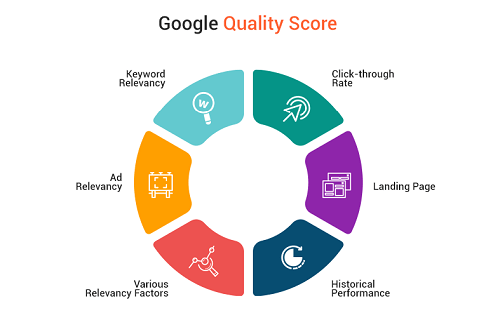In the dynamic world of online advertising, understanding the impact of Google Quality Score is paramount for running successful PPC campaigns. Google Quality Score affects ad matches, keyword quality scores, and overall ad performance. It is a critical metric that assesses the relevance and quality of your keywords, ad, and landing page experience. By delving into the intricacies of keyword quality scores, the elements that determine this score, and the formula used to calculate it, marketers can gain valuable insights into how their ads are perceived by Google’s algorithm.
In this guide, we will explore the inner workings of Google Quality Score, uncovering its impact on ad matches and low-quality score keywords. We will provide actionable tips on optimizing ad and landing page quality to determine a higher quality score. By understanding how it works and affects your entire keyword portfolio, you can gain a competitive edge and propel your PPC campaigns to the new highest of success. Let’s dive in and uncover the strategies that will elevate your ad relevance and achieve a high ad rank in the competitive world of online advertising.

What is Google Ads Quality Score?
Google Ads Quality Score is a crucial performance metric used by Google to evaluate the relevance and effectiveness of your ads in relation to users’ search queries. It is a numeric rating system ranging from 1 to 10, with higher scores indicating greater ad relevance and performance. Quality Score is determined at the keyword level and is an essential aspect of Google Ads campaigns.
The Three Components of Google Ads Quality Score
Expected Click-Through Rate (CTR): This component measures the likelihood of users clicking on your ad when it appears for a specific keyword. It is influenced by historical performance data and user engagement with your ads.
Ad Relevance: Ad relevance evaluates how closely your ad aligns with the user’s search query. Crafting ad copy that matches the targeted keywords and addresses users’ needs directly impacts this component.
Landing Page Experience: The landing page experience assesses the relevance and usability of the webpage users land on after clicking your ad. A well-optimized and relevant landing page can significantly boost your Quality Score.

Why is Google Ads Quality Score Important?
Google Ads Quality Score is paramount in online advertising and holds numerous benefits for advertisers and businesses alike. Let’s explore why Google Ads Quality Score is so crucial:
Ad Performance and Visibility
Quality score influences the performance and visibility of your ads. A higher Quality Score means better ad positions, ensuring your ads appear at the top of search results and increasing the chances of attracting clicks from potential customers.
Cost-Effectiveness
One of the most significant advantages of a high-quality Score is its impact on cost efficiency. Google rewards highly relevant and engaging ads by offering lower costs per click (CPC). This means you can achieve better ad positions and attract more clicks without significantly increasing your bid amounts.
Improved Click-Through Rates (CTR)
A high-quality score signifies that your ads are relevant to users’ search queries. This relevance translates into a higher expected CTR, as Google expects more users to click on your ad when it appears for relevant keywords. Improved CTR can lead to increased website traffic and potential conversions.
Competitive Advantage
A well-optimized Quality Score gives you a competitive edge over other advertisers. Even if your competitors are willing to bid more for certain keywords, a higher Quality Score allows you to achieve better ad positions and visibility, potentially outperforming competitors with lower scores.
Better User Experience
Google strongly emphasizes user experience, and a high-quality Score reflects that your ads and landing pages are relevant and provide value to users. By focusing on relevance and user satisfaction, you contribute to a positive user experience on the Google platform.
Insights for Optimization
Quality Score comprises several factors, such as expected CTR, ad relevance, and landing page experience. Monitoring these individual components provides valuable insights into the strengths and weaknesses of your campaigns. Identifying areas for improvement allows you to optimize your ad groups, keywords, and landing pages for better performance.
Maximize Ad Budget
With a high-quality score, you can maximize your ad budget. By achieving better ad positions and lower CPCs, you can stretch your budget further, reaching a larger audience and potentially increasing your return on investment (ROI).
Align with Google’s Goals
Google aims to deliver the best possible user experience by providing relevant and useful search results. By prioritizing ads with higher Quality Scores, Google ensures that users are presented with ads that closely match their search intent.
Drive Conversions
Relevance is a key driver of conversions. When your ads and landing pages align closely with users’ needs and intent, the likelihood of converting clicks into actions (e.g., purchases, sign-ups, inquiries) increases, driving business growth and success.
Google Ads Quality Score is not just a metric; it is a powerful tool that can significantly impact the success of your advertising campaigns. By focusing on relevancy, providing valuable user experiences, and continuously optimizing your ads and landing pages, you can improve your Quality Score, achieve better ad performance, and reach your marketing objectives more efficiently.

Types of Quality Score
When it comes to Google Ads, Quality Score is not a one-size fits all metric. Google employs different types of Quality Score components, each serving a specific purpose in assessing the performance and relevance of your ads. Let’s delve into the various types and how quality score works:
Keyword Quality Score
The most common and widely recognized type of Quality Score is the Keyword Quality Score. It is assigned to each keyword in your Google Ads account and reflects its performance in the ad auction. The Keyword Quality Score formula is determined based on the expected click-through rate (CTR), ad relevance, and landing page experience for that particular keyword. Improving the Keyword Quality Score involves optimizing your ad copy and landing pages to align better with the targeted keywords.
Ad Group Quality Score
The Ad Group Quality Score represents the overall performance of an ad group, which is a collection of closely related keywords organized under a common theme. While each keyword in the ad group has its keyword quality score, the ad group quality score provides an aggregated assessment of how well the ad group’s keywords and ads work together to match users’ search queries. A well-structured ad group with highly relevant keywords can determine Quality Score positively.
Account-Level Quality Score
The Account level quality score is an overarching evaluation of your entire Google Ads account. It considers the performance of all the ad groups and keywords within the account to gauge its overall effectiveness. This type of quality score is crucial for advertisers managing multiple campaigns, as it helps identify areas of strength and improvement across the account.
Landing Page Quality Score
In addition to the landing page experience component of the keyword quality score, google also assigns a specific landing page quality score. This score focuses solely on the relevance and user experience of the landing page associated with a particular ad. A high landing page provides valuable content and aligns closely with the ad’s message, leading to higher user satisfaction and engagement.
Ad Copy Quality Score
While not officially labeled as a separate type of Quality Score, the relevancy and effectiveness of your ad copy play a critical role in determining the overall quality score. Well-crafted ad copy that includes relevant keywords and speaks directly to users’ search intent can positively impact your ads performance and affect quality score.
Mobile Quality Score
With the increasing importance of mobile devices in online advertising, Google also considers a mobile quality score. This score assesses how well your ads and landing pages perform on mobile devices, ensuring a positive user experience.
Understanding the different types of quality scores can help advertisers better optimize their Google ads campaigns. By focusing on relevancy, user experience, and overall account performance, advertisers can work towards achieving good quality scores, which, in turn, lead to improved ad visibility, better ad positions, and, ultimately, greater success in their online marketing endeavors.
Understanding Ad Rank and Its Influence on Ad Position
In the competitive world of online advertising, achieving optimal ad positioning is a top priority for advertisers. Ad Rank is critical in determining where your ads appear on the search engine results page (SERP). It plays a significant role in the success of your advertising campaigns and directly impacts the visibility and performance of your ads. Let’s delve into Ad Rank, its calculation, and its influence on ad position.
What is Ad Rank?
Ad Rank is the metric used by Google to determine the position of your ads in the ad auction. When a user enters a search query, Google conducts an instantaneous auction to decide which ads will be displayed and in what order. Ad Rank determines the position of your ad relative to other advertisers competing for the same keyword.
Ad Rank Calculation
Ad Rank is calculated based on two primary factors:
Bid Amount: This is the maximum amount you are willing to pay for a click on your ad. It is the monetary aspect of the ad auction, representing your bid for a specific keyword.
Quality Score: Quality Score measures the relevance and performance of your ads and keywords. It includes expected click-through rate (CTR), ad relevance, and landing page experience.
The formula for Ad Rank is as follows:
Ad Rank = Bid Amount x Quality Score
Understanding Quality Score’s Role
Quality Score plays a pivotal role in the ad calculation. It is Google’s way of assessing the quality and relevance of your ads to users’ search queries. A higher quality score number positively impacts your ad rank, allowing you to achieve better ad positions without necessarily having to outbid your competitors.
Influence on Ad Position
Ad Rank directly determines the position of your ads on the SERP. A higher Ad Rank places your ad in a more prominent position, increasing its visibility and the likelihood of attracting clicks from users. Advertisers with higher Ad Ranks often enjoy better ad positions, even if their bid amounts are lower than their competitors.
Ad Position and Ad Rank Trade-Off
The relationship between Ad Position and Ad Rank involves a trade-off. If you aim for a higher ad position, you may need to increase your bid amount or improve your Quality Score. Conversely, a lower ad position may require a lower bid amount or a slight compromise on Quality Score. Striking the right balance between bid amount and Quality Score is essential to achieving optimal ad positioning while staying within your budget.
Understanding Ad Rank and its influence on ad position is crucial for advertisers seeking to maximize the effectiveness of their Google Ads campaigns. By optimizing your Quality Score and strategically managing your bids, you can achieve better ad positions, increased ad visibility, and, ultimately, better results for your advertising efforts.

Strategies to Improve Your Quality Score and Boost Ad Performance
Achieving a high-quality score is pivotal to the success of your Google Ads campaigns. A better quality score leads to improved ad positioning and visibility and helps optimize your ad budget for maxim efficiency. Explore effective strategies to enhance your quality score and boost your Google ad rank.
Keyword Relevance and Organization
Ensure that your keywords are highly relevant to your ad groups and ad text. Group similar keywords into tightly themed ad groups to maintain relevance. This approach enables you to craft more targeted ad copy, making it more likely to resonate with users’ search queries.
Ad Copy Optimization
Craft compelling and engaging ad copy that includes relevant keywords. Use ad extensions strategically to provide additional information and encourage clicks. Test different variations of ad copy to identify which ones perform best and continuously optimize based on results.
Landing Page Experience
Creating a positive landing page experience is crucial for a high-quality score. Ensure that your landing pages align with the ad’s message and deliver the information users seek. The landing page should be user-friendly, load quickly, and have clear calls to action to drive conversions.
Mobile-Friendly Experience
As mobile usage continues to rise, optimizing your landing pages for mobile devices is essential. Mobile-friendly pages provide a better user experience, leading to higher Quality Scores for mobile-targeted ads.
Negative Keywords
Utilize negative keywords to prevent your ads from showing for irrelevant search queries. By excluding unrelated terms, you can improve ad relevance and increase the chances of your ads appearing for the right audience.
Keyword Research and Selection
Thorough keyword research Google Ads is the foundation of a successful campaign. Identify high-performing, relevant keywords that align with your business goals and target audience. Focus on long-tail keywords, which often have higher conversion rates and lower competition.
Ad Extensions
Leverage various ad extensions, such as site links, callouts, and structured snippets, to provide additional information and make your ads more relevant and engaging. Ad extensions not only boost quality scores but also increase the overall visibility of your ads.
Quality Landing Pages
Create unique landing pages for each ad group that delivers on the promise made in the ad copy. A seamless transition from ad to landing page enhances user experience and positively impacts the quality score.
Regular Review and Optimization
Monitor your campaigns regularly to identify underperforming keywords and ads. Based on performance data, optimize your ad groups, keywords, and landing pages. Adjust bids and budgets to focus on high-performing keywords.
Use of Ad Formats
Experiment with various ad formats like responsive search ads and expanded text ads to find what works best for your audience. These formats can improve ad relevance and engagement.
Improve Site Speed
A fast-loading website provides a better user experience and can impact Quality Score. Optimize your website speed to improve landing page experience and Quality Score.
Focus on Conversion Rate
A high conversion rate is an indicator of ad relevance and landing page quality. Improve conversion rates by refining your targeting, ad copy, and landing page design.
By implementing these strategies, you can improve quality score, achieve a better ad position, and drive better ad performance. Focusing on relevance, user experience, and continuous optimization will lead to more effective Google Ads campaigns and better results for your business.
Conclusion
In conclusion, mastering Quality Score is fundamental for advertisers seeking optimal results in their PPC campaigns. Quality Score is a vital metric used by Google to determine the relevance and effectiveness of ads, impacting ad rank, cost per click, and overall campaign performance. By focusing on ad quality, relevance, and landing page experience, advertisers can positively influence their Quality Scores and, in turn, their ad positions and costs.
To improve quality score columns, advertisers should focus on creating highly relevant ad copy that aligns with their targeted keywords and meets the needs of users’ search queries. Implementing effective keyword strategies, including match types and negative keywords, ensures that ads are displayed to the most relevant audience, thus boosting click-through rates and ad relevance. Crafting well-optimized landing pages with clear call-to-actions and valuable content enhances the overall user experience, increasing the likelihood of conversion and improving landing page experience scores.
Moreover, employing Google Analytics and other diagnostic tools helps advertisers monitor campaign performance, identify areas of improvement, and make data-driven decisions to enhance CTR and Quality Scores. Regularly analyzing search terms and click-through rates allows advertisers to refine their keyword list, ensuring they target the most popular and relevant keywords that align with user intent. Advertisers can also modify ad groups, delete underperforming keywords, and adjust bid strategies to further optimize campaign performance.
Ultimately, by following best practices such as boosting CTR, increasing relevance, and maintaining high ad quality, advertisers can improve their quality scores and achieve higher ad ranks, which translates to better visibility, higher click-through rates, and potentially lower costs per click. The process of achieving and maintaining a good quality score requires ongoing optimization, continuous monitoring, and a commitment to providing users with a positive and relevant experience. By mastering the intricacies of quality scores and leveraging their insights, advertisers can pave the way for a successful and efficient PPC.

A PPC specialist who started with organic social media. For several years, the core of his activities are:- Google Ads, Microsoft Ads, Meta Ads, TikTok Ads, Twitter Ads, Linkedin Ads. He has led campaigns with a global reach, e.g. for FootballTeam, G2A, ETOTO, as well as many smaller campaigns in the sports, construction and financial industries. Has full focus on ROAS. Privately, a fan of football, history of wars and Star Wars.

